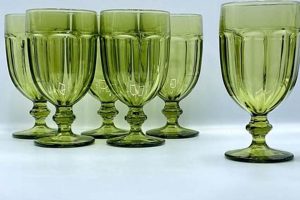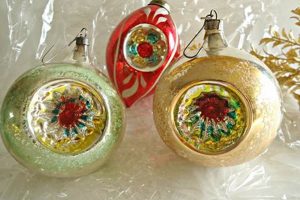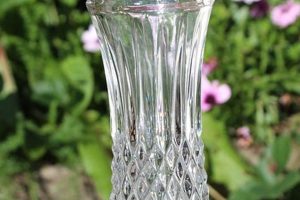These decorative hardware pieces, often dating back to the late 19th and early 20th centuries, are characterized by their construction from clear or colored glass, typically featuring intricate patterns or designs molded into their surface. An example would be a clear, pressed glass knob with a starburst pattern, commonly found in homes built during the Victorian or Art Deco periods.
Their appeal lies in the combination of functionality and aesthetic value. They offer a tangible connection to the past, providing a unique decorative element that complements both traditional and contemporary interior designs. These items evoke a sense of nostalgia, reflecting craftsmanship and design sensibilities of bygone eras. Their enduring popularity reflects an appreciation for durability and timeless style.
The subsequent discussion will delve into various aspects, including identifying characteristics, historical background, restoration techniques, and sourcing options for acquiring and preserving these historical hardware components.
Tips for Acquiring and Maintaining Glass Door Hardware
The following guidelines offer practical advice for individuals interested in acquiring, authenticating, and preserving antique glass hardware.
Tip 1: Authenticate Originality: Examine the glass for imperfections such as bubbles or striations, which are characteristic of older manufacturing processes. Consistent surface texture and pattern symmetry across multiple pieces can suggest modern reproductions.
Tip 2: Inspect for Damage: Carefully assess the glass for chips, cracks, or cloudiness. Minor imperfections may be acceptable, but significant damage can compromise structural integrity and aesthetic appeal.
Tip 3: Evaluate Metal Components: Investigate the condition of the spindle, roses, and other metal parts. Rust, corrosion, or stripped threads can hinder functionality and require restoration or replacement.
Tip 4: Research Historical Context: Identify the period and manufacturer of the hardware to understand its original design and value. Historical catalogs or online resources can provide valuable information.
Tip 5: Clean Gently: Use mild soap and water with a soft cloth to clean the glass. Avoid abrasive cleaners, which can scratch the surface. For metal components, use appropriate metal cleaners depending on the material.
Tip 6: Secure Mounting: Ensure proper alignment and secure mounting to prevent strain on the glass. Use appropriate screws and mounting hardware to avoid damaging the surrounding door or frame.
Tip 7: Store Properly: When not in use, store the hardware in a dry, padded container to prevent damage from impact or environmental factors.
Adhering to these recommendations can help ensure the longevity and beauty of valuable antique glass hardware.
The subsequent section will explore specific restoration techniques and considerations for preserving the original character of these historical artifacts.
1. Material Quality
The enduring appeal and value of these artifacts are inextricably linked to the properties and purity of the glass used in their manufacture. Variations in composition and production processes directly impact clarity, color, and durability, affecting both aesthetic appeal and long-term preservation. A high-quality glass composition, free from impurities, results in a brighter, more refractive piece, capable of exhibiting intricate molded designs with greater definition. Conversely, inferior glass formulations may exhibit cloudiness, discoloration, or increased fragility, diminishing its visual and structural integrity. For example, knobs crafted from lead crystal are typically more brilliant and heavier than those made from soda-lime glass, thus commanding a higher market value. The presence of imperfections, such as bubbles or striations, while sometimes indicative of age, can also detract from the overall aesthetic if excessively pronounced.
The method of glass production further contributes to the overall material quality. Hand-pressed or molded glass techniques, common in earlier manufacturing, often resulted in unique variations and subtle imperfections that added to the character of each piece. Machine-produced glass, introduced later, offered greater consistency but lacked the individual nuances of handmade examples. Furthermore, colorants added to the glass batch, such as manganese to neutralize impurities or uranium to achieve a vibrant green hue, significantly alter the glass’s properties and visual characteristics. A prime example is the presence of “sun purpled” glass, where prolonged exposure to ultraviolet light causes manganese-infused glass to gradually turn amethyst, adding an element of historical interest and uniqueness.
In conclusion, the connection between material quality and the valuation of these artifacts is undeniable. A thorough understanding of the glass composition, production methods, and potential defects enables informed decisions regarding acquisition, restoration, and preservation. Appreciating the subtleties of material quality not only enhances the aesthetic enjoyment but also ensures the long-term viability of these tangible links to the past. Challenges remain in accurately dating and authenticating pieces based solely on material analysis; therefore, contextual factors like hardware design and manufacturing marks are essential considerations.
2. Design Variation
The breadth of design expressions found within glass door hardware significantly influences their historical and aesthetic value. These variations, reflecting evolving architectural styles and manufacturing techniques, serve as a critical indicator of provenance and authenticity.
- Geometric Patterns
Simple geometric shapes, such as circles, squares, and facets, were prevalent in early production, reflecting minimalist aesthetics and ease of manufacturing. These designs, often found in vernacular architecture, highlight the utilitarian function while adding subtle decorative elements. A common example includes a plain round knob with a starburst or diamond-cut pattern, frequently encountered in homes built in the late 19th and early 20th centuries. The simplicity of these designs facilitated mass production, contributing to their widespread use.
- Floral and Organic Motifs
More elaborate floral and organic designs emerged with advancements in glass molding technology, coinciding with the Victorian and Art Nouveau periods. These designs featured intricate representations of flowers, leaves, and vines, showcasing the craftsmanship and artistry of the era. Examples include knobs adorned with detailed roses, lilies, or grapevines, often incorporating colored glass accents. The complexity of these motifs required skilled artisans and specialized molds, resulting in higher-value pieces.
- Art Deco Influences
The Art Deco movement brought a distinctive geometric flair, characterized by stylized patterns and bold angular forms. These designs often incorporated stepped patterns, chevrons, and sunburst motifs, reflecting the era’s fascination with modernity and technological progress. Colored glass, particularly opaque shades like black, white, and emerald green, became popular, adding a sense of sophistication and glamour. Examples include octagonal knobs with geometric engravings or multi-tiered designs that evoke the era’s architectural aesthetic.
- Color and Texture Variations
Beyond form, variations in glass color and surface texture contribute significantly to design diversity. Clear, frosted, etched, and colored glass each offer unique aesthetic qualities. Colored glass, achieved through the addition of metallic oxides during the manufacturing process, ranged from subtle tints to vibrant hues. Etched surfaces provided a textured finish, adding depth and visual interest. Examples include clear knobs with etched floral patterns, frosted glass knobs for privacy, or colored glass knobs in shades of amber, cobalt blue, or ruby red. These variations allowed for customization and aesthetic adaptation to specific architectural styles.
These design variations underscore the evolving stylistic preferences and technological innovations that shaped the aesthetic of glass door hardware. Understanding these distinctions is crucial for accurate identification, authentication, and preservation of these valuable artifacts. The interplay between form, color, and texture provides a rich tapestry of design expressions that reflect the cultural and historical context of their creation.
3. Historical Era
The temporal context in which glass door hardware was manufactured significantly impacts its design, materials, and production methods. Understanding the historical era is paramount to accurately assessing the authenticity, value, and stylistic relevance of these artifacts.
- Victorian Era (1837-1901)
This period witnessed a proliferation of ornate designs characterized by floral motifs, intricate patterns, and a variety of glass colors. Mass production techniques made these items more accessible, while innovations in glass molding allowed for complex detailing. For example, knobs featuring pressed glass roses or grapevines were commonly incorporated into homes, reflecting the era’s emphasis on decorative embellishment and naturalistic themes. This era’s production quality affects the rarity of “glass door knobs vintage”.
- Art Nouveau Era (1890-1910)
This era favored flowing lines, organic forms, and asymmetrical designs. Glass door hardware reflected this aesthetic with motifs inspired by nature, such as stylized flowers, insects, and swirling patterns. Colored glass, particularly iridescent or opalescent varieties, was often used to enhance the decorative effect. The presence of these characteristics can aid in identifying and dating “glass door knobs vintage” to the Art Nouveau period.
- Art Deco Era (1920-1939)
This era embraced geometric shapes, streamlined designs, and bold colors. Glass door hardware from this period often featured stepped patterns, chevrons, and stylized sunburst motifs. Opaque glass in shades of black, white, and emerald green was popular, reflecting the era’s fascination with modernity and technological progress. Identifying these features helps categorize vintage glass door hardware within the Art Deco movement.
- Mid-Century Modern Era (1945-1965)
This era emphasized simplicity, functionality, and clean lines. Glass door hardware from this period often featured minimalist designs with smooth surfaces and simple geometric shapes. Clear or lightly tinted glass was favored, reflecting the era’s emphasis on understated elegance and functional design. Example: Simple clear knobs with minimal embellishments were common in homes built during the mid-20th century. Identifying pieces to this era could be rare for the “glass door knobs vintage” because not much design.
In summary, the historical era provides a critical framework for understanding the design, materials, and production techniques associated with glass door hardware. By examining the stylistic characteristics and historical context, collectors and enthusiasts can more accurately identify, authenticate, and appreciate the unique qualities of these historical artifacts.
4. Hardware Condition
The physical integrity of antique glass door hardware is a primary determinant of its value, functionality, and aesthetic appeal. The condition of the glass and associated metal components directly influences its desirability among collectors and its suitability for practical use.
- Glass Integrity
Chips, cracks, and cloudiness in the glass significantly detract from its value. Minor surface scratches may be acceptable, depending on the piece’s age and rarity, but significant damage compromises its structural stability and visual appeal. For example, a large crack across the face of a knob can render it unusable and substantially reduce its market value. Cloudiness, often caused by prolonged exposure to moisture or harsh chemicals, diminishes the glass’s clarity and brilliance, impacting its aesthetic appeal. This is key in the “glass door knobs vintage” evaluation.
- Metal Component Corrosion
Rust, corrosion, and pitting on the spindle, shank, and mounting hardware can affect functionality and structural integrity. Corroded metal components may prevent the knob from turning smoothly or attaching securely to the door. For example, a rusted spindle can seize, rendering the knob inoperable. Similarly, corroded mounting screws may break during installation, necessitating replacement with modern hardware, which can detract from the antique’s authenticity. Evaluation of the material to see if the “glass door knobs vintage” metal is corrosive is part of the process.
- Spindle and Thread Wear
Worn threads on the spindle or knob shank can cause instability and prevent the knob from tightening properly. Stripped threads may result in the knob loosening over time, making it difficult to operate the door. Examples include a spindle with rounded threads that no longer grip the set screws or a knob shank with stripped threads that cannot be securely fastened. If the “glass door knobs vintage” is not threaded then it may not be a concern.
- Originality of Components
The presence of original, matching hardware components significantly enhances the value of an antique glass door knob. Replacements, particularly those made from modern materials, can diminish the piece’s historical authenticity and collector appeal. For example, a knob with a replaced spindle or set screws may be less desirable than a complete, original set. Mismatched components, such as a modern shank attached to an antique glass knob, further detract from its value. The authentic set screw for the “glass door knobs vintage” matters to its market value.
Assessing the condition of glass door hardware requires a comprehensive evaluation of both the glass and metal components. While minor imperfections may be expected in antique pieces, significant damage or non-original components can substantially reduce their value and functionality. Careful inspection and proper restoration techniques are essential for preserving these historical artifacts.
5. Rarity Assessment
The evaluation of scarcity plays a pivotal role in determining the value and desirability of these historical artifacts. The limited availability of certain designs, materials, or manufacturing periods can significantly elevate the collector appeal and market price of these items. A comprehensive rarity assessment necessitates considering various factors that influence the scarcity of specific examples.
- Limited Production Runs
Designs produced in limited quantities due to short-lived trends, specialized manufacturing techniques, or limited availability of raw materials often command higher prices. For instance, certain colored glass varieties or intricate patterns may have been manufactured for only a brief period, resulting in fewer surviving examples. The survival rate of such “glass door knobs vintage” greatly determines its value.
- Manufacturer Exclusivity
Knobs produced by lesser-known or defunct manufacturers can be considered rarer than those from well-established companies with extensive production records. The absence of readily available documentation and the smaller distribution networks of these manufacturers contribute to the scarcity of their products. Identifying “glass door knobs vintage” from small companies can increase value.
- Design Peculiarities and Variations
Knobs exhibiting unique design elements, such as unconventional shapes, unusual color combinations, or experimental manufacturing techniques, can be highly sought after by collectors. These deviations from standard production models often resulted from intentional design choices or manufacturing errors, making them particularly scarce and desirable. Finding a “glass door knobs vintage” that is unique is a great selling point.
- Geographic Distribution
The regional prevalence of certain designs can influence their perceived rarity in different markets. Knobs that were primarily distributed in specific geographic areas may be less common in other regions, thereby increasing their value for collectors seeking to acquire specimens from diverse sources. If “glass door knobs vintage” is only popular in an area, it may be rare everywhere else.
In summary, assessing the rarity of glass door hardware involves a multifaceted analysis of production quantities, manufacturer identity, design characteristics, and geographic distribution. By considering these factors, collectors and enthusiasts can gain a deeper appreciation for the historical significance and market value of these tangible links to the past. Identifying rarity of “glass door knobs vintage” is a key selling point.
Frequently Asked Questions
The following section addresses common inquiries and concerns regarding these historical hardware items, providing concise and informative answers.
Question 1: How can authenticity of antique glass door knobs be verified?
Authenticity verification involves examining the glass for imperfections indicative of older manufacturing processes, such as bubbles or striations. Researching manufacturer markings and comparing designs to historical catalogs can also aid in confirmation. The presence of consistent surface texture and pattern symmetry across multiple pieces could suggest modern reproductions.
Question 2: What are the primary factors affecting the valuation of vintage glass door knobs?
Valuation is influenced by several factors, including the quality of the glass, the rarity of the design, the historical period of manufacture, and the overall condition of both the glass and associated metal components. Knobs from well-known manufacturers or those exhibiting unique design features typically command higher prices.
Question 3: What are the best practices for cleaning and maintaining glass door hardware?
Cleaning should be performed with mild soap and water applied with a soft cloth. Abrasive cleaners should be avoided, as they can scratch the glass surface. Metal components can be cleaned with appropriate metal cleaners, depending on the material. Regular cleaning helps prevent the accumulation of dirt and grime that can obscure the glass’s clarity.
Question 4: How should damaged or incomplete glass door knobs be restored?
Restoration may involve repairing chips or cracks in the glass using specialized adhesives or replacing missing metal components with period-appropriate replacements. It is crucial to preserve the original character of the hardware by using compatible materials and techniques. Professional restoration services are recommended for valuable or heavily damaged pieces.
Question 5: Are modern reproductions of glass door knobs readily distinguishable from original antique examples?
Modern reproductions often lack the subtle imperfections and variations found in original antique examples. The quality of the glass and metal components may also differ, with modern pieces typically exhibiting a more uniform and polished appearance. Close examination and comparison with known authentic examples can help distinguish reproductions from originals.
Question 6: Where are reputable sources for acquiring authentic vintage glass door knobs?
Reputable sources include antique stores, architectural salvage yards, estate sales, and online marketplaces specializing in vintage hardware. Verifying the seller’s reputation and examining the item’s description and photographs carefully are essential to ensure authenticity and value.
In conclusion, careful evaluation, proper maintenance, and informed sourcing are crucial when engaging with antique glass door hardware. These guidelines provide a foundational understanding for collectors and enthusiasts seeking to preserve and appreciate these historical artifacts.
The subsequent section will discuss how to incorporate these elements into modern design schemes.
Conclusion
The preceding discussion has provided an overview of “glass door knobs vintage,” encompassing aspects such as authenticity, valuation, restoration, and sourcing. These decorative hardware pieces offer a tangible connection to historical design aesthetics and manufacturing techniques. Their enduring appeal stems from the combination of functional utility and visual elegance, making them valuable assets for collectors and homeowners seeking to incorporate historical elements into contemporary spaces.
Continued research and careful preservation efforts are essential to safeguard these tangible links to the past. By understanding the nuances of their design, materials, and historical context, individuals can appreciate the unique beauty and value that these artifacts contribute to our built environment. The preservation of “glass door knobs vintage” ensures their continued availability for future generations.







